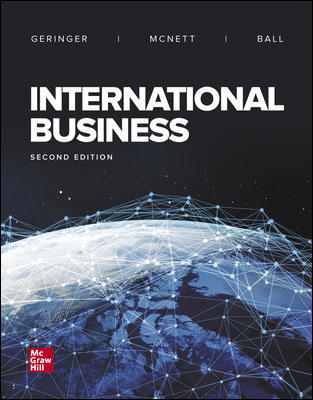Test Bank for International Business, 2nd Edition, Michael Geringer, Jeanne McNett, Donald Ball
$35.00 Original price was: $35.00.$26.50Current price is: $26.50.
Test Bank for International Business, 2nd Edition, Michael Geringer, Jeanne McNett, Donald Ball,
This is completed downloadable of Test Bank for International Business, 2nd Edition, Michael Geringer, Jeanne McNett, Donald Ball

Product Details:
- ISBN-10 : 1260566218
- ISBN-13 : 978-1260566215
- Author: Michael Geringer, Jeanne McNett, Donald Ball
Empower students to develop their global mindset! Up-to-date, relevant and engaging, Geringer: International Business 2e provides a flexible, modular format for instructors along with student-focused features that make the study of IB personally relevant for every student!
Table of Content:
- Module 1: The Challenging Context of International Business
- What Is International Business and What Is Different about It?
- The Influence of External and Internal Environmental Forces
- The Domestic Environment
- The Foreign Environment
- The International Environment
- Is Internationalization of Business a New Trend, and Will It Continue?
- The Growth of International Firms and International Business
- Expanding Number of International Companies
- Foreign Direct Investment and Exporting Are Growing Rapidly
- What Is Driving the Internationalization of Business?
- Political Drivers
- Technological Drivers
- Market Drivers
- Cost Drivers
- Competitive Drivers
- What Are the Arguments for and against the Globalization of Business?
- Concerns with Globalization
- Arguments Supporting Globalization
- Summary
- Key Terms
- Critical Thinking Questions
- Research Task
- Minicase
- Notes
- Module 2: International Trade and Investment
- International Trade
- Volume of International Trade
- How Evenly Has Trade Grown?
- Which Nations Account for the Most Exports and Imports?
- Direction of Trade
- The Increasing Regionalization of Trade
- Major Trading Partners: Their Relevance for Managers
- Major Trading Partners of the United States
- Explaining Trade: International Trade Theories
- Mercantilism
- Theory of Absolute Advantage
- Theory of Comparative Advantage
- How Exchange Rates Can Change the Direction of Trade
- Some Newer Explanations for the Direction of Trade
- Summary of International Trade Theory
- Foreign Investment
- Portfolio Investment
- Foreign Direct Investment (FDI)
- Does Trade Lead to FDI?
- Explaining FDI: Theories of International Investment
- Monopolistic Advantage Theory
- Strategic Behavior Theory
- Internalization Theory
- Dynamic Capabilities Theory
- Eclectic Theory of International Production
- Summary
- Key Terms
- Critical Thinking Questions
- Research Task
- Minicase
- Notes
- Module 3: Sociocultural Forces
- What Is Culture and Why Is It Important?
- Culture Affects All Business Functions
- Marketing
- Human Resources
- Production and Procurement
- Accounting and Finance
- Preferred Leadership Styles
- How Culture Shows Itself
- Aesthetics
- Religion
- Material Culture
- Language
- Societal Organization
- Special Focus: Gift Giving in Business
- Culture Frameworks
- Hall’s High and Low Context
- Kluckhohn and Strodtbeck’s Cultural Orientations Framework
- Hofstede’s Six Dimensions
- Trompenaars’s Seven Dimensions
- When Does Culture Matter? The Global Mind-Set
- Going Forward: Cultural Paradoxes and a Caution
- Rules of Thumb for Managers Doing Business across Cultures
- Summary
- Key Terms
- Critical Thinking Questions
- Research Task
- Minicase
- Notes
- Module 4: Sustainability and Natural Resources
- Sustainability in the Business Context
- Systems for Achieving Sustainability
- Life Cycle Assessment
- Cradle-to-Cradle Design
- Tools for Measuring Sustainability
- United Nations Global Compact
- Global Reporting Initiative
- Carbon Disclosure Project
- Footprinting
- Characteristics of Environmentally Sustainable Business
- Limits as Part of the Sustainability Context
- Interdependence as Part of the Sustainability Context
- Equity in Distribution as Part of the Sustainability Context
- The Stakeholder Model for Sustainable Business
- Geography: Describing Our Natural Capital
- Location: Political and Trade Relationships
- Topography
- Climate
- Natural Resources
- Nonrenewable Energy Sources
- Renewable Energy Sources
- Nonfuel Minerals
- Summary
- Key Terms
- Critical Thinking Questions
- Research Task
- Minicase
- Notes
- Module 5: Political Forces That Affect Global Trade
- Governments and the Ownership of Business
- Nationalization: Why Governments Get Involved
- Privatization: Why Governments Sell Businesses
- Government Stability and Protection
- Stability: Issues with Lack of Peace and Predictability
- Protection from Unfair Competition
- Protection from Terrorism, Cybercrime, and Other Threats
- Country Risk Assessment and Countermeasures to Threats
- Government Intervention in Trade
- Reasons for Restricting Trade
- Tariff Barriers
- Nontariff Barriers
- Summary
- Key Terms
- Critical Thinking Questions
- Research Task
- Minicase
- Notes
- Module 6: Intellectual Property Rights and Other Legal Forces
- Types of Legal Systems
- Civil Law
- Common Law
- Religious Law
- International Legal Forces
- Rule of Law
- What is International Law?
- Sources of International Law
- General Legal Concerns in Global Business
- Extraterritoriality
- Performance of Contracts
- Litigation
- Intellectual Property Rights
- Patents
- Trademarks
- Trade Names
- Copyrights
- Trade Secrets
- Standardizing Laws Around the World
- Some Specific National Legal Forces
- Competition Laws
- Trade Obstacles
- Tort Law
- Miscellaneous Laws
- Foreign Corrupt Practices Act
- Accounting Law
- Summary
- Key Terms
- Critical Thinking Questions
- Research Task
- Minicase
- Notes
- Module 7: Economic and Socioeconomic Forces
- International Economic Analyses
- Levels of Economic Development
- Dimensions That Describe the Economy and Their Relevance for International Business
- Measuring the Size of an Economy
- Economic Growth Rate
- Income Distribution
- Private Consumption
- Unit Labor Costs
- Other Economic Dimensions
- Socioeconomic Dimensions of the Economy and Their Relevance for International Business
- Total Population
- Age Distribution
- Population Density and Distribution
- Other Socioeconomic Dimensions
- Summary
- Key Terms
- Critical Thinking Questions
- Research Task
- Minicase
- Notes
- Module 8: The International Monetary System and Financial Forces
- The International Monetary System: A Brief History
- The Gold Standard
- The Bretton Woods System
- The Central Reserve/National Currency Conflict
- The Floating Currency Exchange Rate System
- Current Currency Arrangements
- The Bank for International Settlements
- Financial Forces: Fluctuating Currency Values
- Fluctuating Currency Values
- Why Foreign Currency Exchange Occurs
- Exchange Rate Quotations and the FX Market
- Causes of Exchange Rate Movement
- Exchange Rate Forecasting
- Financial Forces Governments Can Exert
- Currency Exchange Controls
- Taxation
- Inflation and Interest Rates
- Balance of Payments
- Summary
- Key Terms
- Critical Thinking Questions
- Research Task
- Minicase
- Notes
- Module 9: International Competitive Strategy
- What Is International Strategy, and Why Is It Necessary?
- Why Plan Globally?
- The Process of Global Strategic Planning
- Step 1: Analyze Domestic, International, and Foreign Environments
- Step 2: Analyze Corporate Controllable Variables
- Step 3: Define the Corporate Mission, Vision, and Values Statements
- Step 4: Set Corporate Objectives
- Step 5: Quantify the Objectives
- Step 6: Formulate the Competitive Strategies
- Regional Strategies for Competing Globally
- Step 7: Prepare Tactical Plans
- Strategic Plan Features and Implementation Facilitators
- Sales Forecasts and Budgets
- Facilitation Tools for Implementing Strategic Plans
- Performance Measures
- Kinds of Strategic Plans
- Time Horizon
- Level in the Organization
- Methods of Planning
- New Directions in Planning
- Who Does Strategic Planning?
- How Strategic Planning Is Done
- Contents of the Plan
- Summary
- Key Terms
- Critical Thinking Questions
- Research Task
- Minicase
- Notes
- Module 10: Organizational Design and Control
- How Does Organizational Design Impact International Companies?
- Evolution of International Company Structure
- International Division Structure
- International Product Structure
- Geographic Region Structure
- Global Functional Structure
- Hybrid Organizational Structures
- Matrix Organizations
- Matrix Overlay
- Strategic Business Units
- Current Organizational Trends
- Requirements for the Future of International Companies
- Where Decisions Are Made in Wholly Owned Subsidiaries
- Standardization of the Company’s Products and Equipment
- Competence of Subsidiary Management and Headquarters’ Reliance on It
- Size and Age of the IC
- Headquarters’ Willingness to Benefit the Enterprise at the Subsidiary’s Expense
- The Subsidiary’s Frustration with its Limited Power
- Where Decisions Are Made in Joint Ventures and Subsidiaries Less Than 100 Percent Owned
- Loss of Freedom and Flexibility
- Control Can Be Had Even with Limited or No Ownership
- Reporting
- Financial Reporting
- Technological Reporting
- Reporting about Market Opportunities
- Political and Economic Reporting
- Summary
- Key Terms
- Critical Thinking Questions
- Research Task
- Minicase
- Notes
- Module 11: Global Leadership Issues and Practices
- The Global Mind-Set
- Global Leadership: What It Is and Why It Matters
- How Global Leadership Differs from Domestic Leadership
- The Challenge of Finding Global Leaders with the “Right Stuff”
- What Competencies Are Required for Effective Global Leadership?
- Selecting and Developing Effective Global Leaders
- Assessing Global Leadership Competencies
- Models for Developing Global Leaders
- Tools and Techniques for Developing Global Leadership Skills
- Leading Global Teams
- Leading Teams
- Complexity for Teams in the Global Context
- Global Team Leadership and Culture
- Virtual and Geographically Dispersed Teams
- Performance Management in Global Teams
- Leading Global Change
- Change Models
- Change and Culture
- Summary
- Key Terms
- Critical Thinking Questions
- Research Task
- Minicase
- Notes
- Module 12: International Markets: Assessment and Entry Modes
- Market Screening Approaches and Techniques
- Initial Screening—Basic Needs Potential
- Second Screening—Financial and Economic Forces
- Third Screening—Political and Legal Forces
- Fourth Screening—Cultural Forces
- Fifth Screening—Competitive Forces
- Final Selection of New Markets
- Segment Screening
- Trade Missions and Trade Fairs
- Research in the Local Market and as Practiced
- What Methods Are Available for Entering Foreign Markets?
- Nonequity Modes of Entry
- Equity-Based Modes of Entry
- Summary
- Key Terms
- Critical Thinking Questions
- Research Task
- Minicase
- Notes
- Module 13: Marketing Internationally
- Differences between Domestic and International Trade
- The Marketing Mix
- Standardize, Adapt, or Start From Scratch?
- Product Strategies
- Modifying Types of Products
- Industrial Products
- Consumer Products
- Services
- Foreign Environmental Forces
- Promotional Strategies
- Advertising
- Media Availability and Internet Advertising
- Type of Product
- Foreign Environmental Forces
- Neither Purely Global nor Purely Local
- Personal Selling
- Sales Promotion
- Public Relations
- Pricing Strategies
- Standardizing Prices
- Foreign National Pricing
- International Pricing
- Distribution Strategies
- Standardizing Distribution
- Foreign Environmental Forces
- Summary
- Key Terms
- Critical Thinking Questions
- Research Task
- Minicase
- Notes
- Module 14: Managing Human Resources in an International Context
- Worldwide Labor Conditions
- Overall Size of the Workforce
- Aging of Populations
- Urbanization of Workforce
- Immigrant Labor
- Guest Workers
- Brain Drain
- Labor Unions
- The Strategic Approach to International Human Resource Management
- Recruitment and Selection of Employees
- Ethnocentric Staffing Policy
- Polycentric Staffing Policy
- Regiocentric Staffing Policy
- Geocentric Staffing Policy
- Training and Development of Employees
- Home- or Parent-Country National
- Host-Country National
- Third-Country National
- Expatriates
- The Expatriate’s Family
- Preparation for the Transition: Language Training
- Expatriate Services
- Repatriation—The Shock of Returning Home
- Compensation for International Assignments
- Salaries
- Allowances
- Bonuses
- Compensation Packages Can Be Complicated
- Compensation of Third-Country Nationals
- International Status
- Perks
- What’s Important to You?
- Summary
- Key Terms
- Critical Thinking Questions
- Research Task
- Minicase
- Notes
- Module 15: International Accounting and Financial Management
- Accounting and Foreign Currency
- The Purpose of International Accounting
- Foreign Currency Transactions
- Foreign Currency Consolidation: Translation and Functional Currency
- International Accounting Standards on the Path of Convergence
- Accounting and Culture
- Triple-Bottom-Line Accounting
- International Financial Management: Capital Structure of the Firm
- International Financial Management: Cash Flow Management
- Why Funds Are Moved and Useful Techniques for Moving Them
- International Finance Center
- Multilateral Netting
- Leading and Lagging
- Foreign Exchange Risk Management
- Transaction Exposure
- Translation Exposure
- Economic Exposure
- Taxation
- Summary
- Key Terms
- Critical Thinking Questions
- Research Task
- Minicase
- Notes
- Bonus Module A: International Institutions from a Business Perspective
- What Are Institutions, and Why Are They Useful?
- Institutional Theory
- Types of Institutions
- The United Nations
- General UN Support of Business
- Direct UN Impact on Business
- UN Organization
- International Monetary Institutions
- International Monetary Fund
- The World Bank
- World Development and Trade Organizations
- Organisation for Economic Co-operation and Development (OECD)
- World Trade Organization
- Economic Integration Agreements
- Free Trade Area
- Common Market
- Economic Integration
- Examples of Economic Integration Agreements
- Summary
- Key Terms
- Critical Thinking Questions
- Research Task
- Minicase
- Notes
- Bonus Module B: Export and Import Practices
- Sources of Export Information, Counseling, and Support
- Mistakes Made By New Exporters
- Export Marketing Plan
- Incoterms, Pricing, Terms of Sale, and Payment
- Incoterms
- Pricing
- Terms of Sale
- Export Payment Procedures
- Export Financing
- Export Procedures and Export Documents
- Export Shipments
- Importing
- Sources for Imports
- Customhouse Brokers
- Import Duties
- Summary
- Key Terms
- Critical Thinking Questions
- Research Task
- Minicase
- Sample Outline for an Export Marketing Plan
- Notes
- Bonus Module C: Global Operations and Supply Chain Management
- Managing Global Supply Chains
- Design of Products and Services
- Sourcing Globally
- Reasons for Sourcing Globally
- Global Sourcing Arrangements
- Importance of Global Sourcing
- The Increasing Use of Electronic Purchasing for Global Sourcing
- Manufacturing Systems and Logistics
- Advanced Production Techniques Can Enhance Quality and Lower Costs
- Logistics and Supply Chains
- Standardization and the Management of Global Operations
- Benefits of Standardization of Global Operations
- Impediments to Standardization of Global Operations
- Some Design Solutions
- Summary
- Key Terms
- Critical Thinking Questions
- Research Task
- Minicase
- Notes
- Glossary
- Company Name Index
- Subject Index
People Also Search:
international business
international business 2nd edition
international business 2nd edition download scribd
international business 2nd edition test bank download pdf
international business 2nd edition by shad morris james oldroyd
Related products
Test Bank
Test Bank for Operating Systems: Internals and Design Principles, 7th Edition: William Stallings











